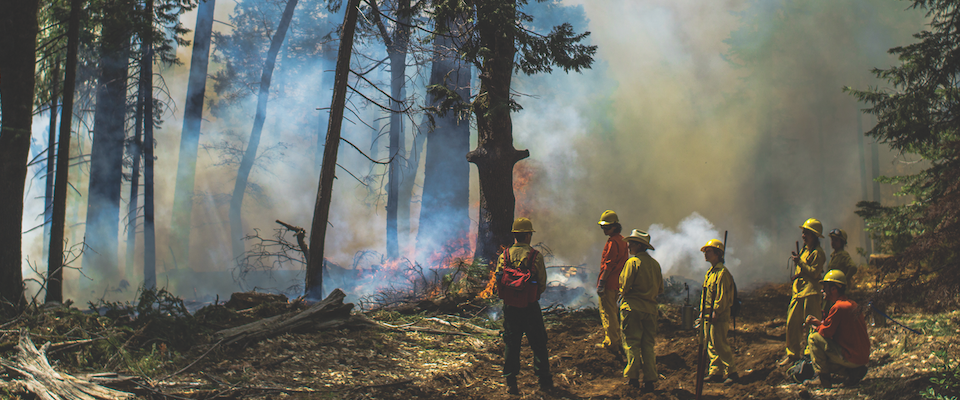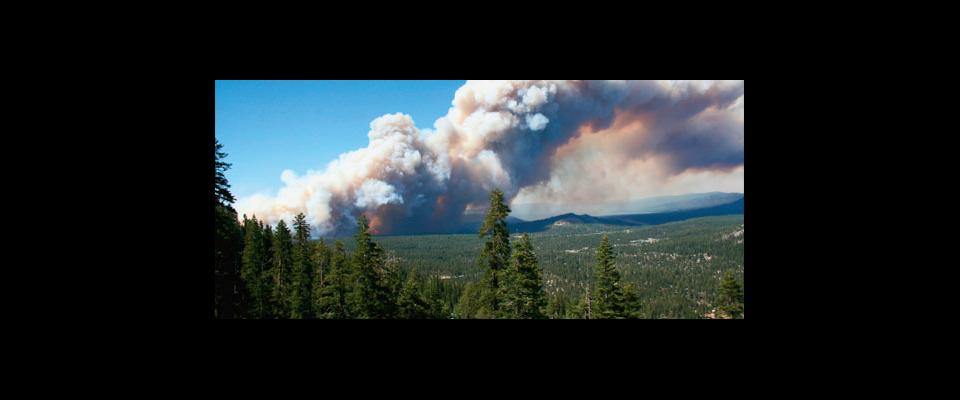The King Fire continues to rage. As of this writing, it has scorched 87,000 acres of Sierra forest and burned down at least 10 homes and 22 outbuildings. The fire also menaced Berkeley’s Blodgett Forest Research Station, the site of a seminal study on fuel-reduction treatments.
“It got within a mile, and then the wind shifted,” says Berkeley fire science professor Scott Stephens. “Firefighters have conducted some successful backburning, so the situation is fairly secure.”
But Stephens thinks that Blodgett would have fared well even if the King Fire had penetrated the property. He notes that much of the station’s woodland has been subjected to the various fuel reduction treatments favored by progressive foresters. As a result, he says, Blodgett is reasonably fire resistant.
“I think we would have maintained 50 percent or more of the forest cover, and the trees that did burn would have been in the kind of mosaic pattern that’s desirable,” says Stephens. “We have a pretty good idea of what works. Our recent study involved fuel-control treatments of different stands of timber with different combinations of prescriptive fire and mechanical thinning. In general, the outcomes were very positive.”
Stephens is hardly surprised by these apocalyptic blazes; he has warned of them for years. It’s likely that climate change—and the warmer temperatures and reduced snowpack that accompany it—are contributing to the wildfire boom, says Stephens. But the main problem is lousy forestry policy.
“These fires are symptomatic of our current landscapes, landscapes we created through poor forest management,” he says.
Stephens observes that decades of clear-cutting were followed by extensive replanting. But federal and state managers treated burned areas as tree farms, not natural forests. They planted trees—mainly ponderosa pine—on tight grids. And the trees did well. Too well, actually. They grew up thick and lush, producing veritable carpets of highly resinous, inflammable saplings.
At that point, they should have been thinned and thinned aggressively, says Stephens. They weren’t.
“The money for management simply hasn’t been there,” he says.
The situation is compounded by the gridlock between environmentalists and commercial foresters. The former favor thinning, but they want all logging plans to leave the larger trees, particularly those with trunks over 30 inches in diameter. But the timber companies maintain it is necessary to take a significant number of bigger trees to fund thinning and restoration programs.
Stephens generally favors the enviro position. Landscape-scale wildfire damage is driven by vast acreages of small-diameter, closely-packed trees, he says. By leaving the larger trees, the essential character of a natural forest can be maintained, even accelerated. And he thinks markets can be found for products produced from thinned, scrawny trees.
In a properly managed forest, an 87,000-acre wildfire would be a good excuse for a party.
“The important thing is to remove that fuel ladder, so that any fires that do start are lower in intensity,” he says. “Fire is not only good for California’s forests—it’s essential. It returns nutrients to the soil, controls pests, creates a mosaic of different habitats. Historically, ‘natural’ wildfires in California did far more good than harm. But the current fires are anything but natural. They’re so intense, so huge, that forests are proving incapable of recovering from them. Many burned areas are unlikely to return as forests, and those that do will take a long time. Maybe a century or more.”
In a properly managed forest, Stephens continues, “an 87,000 acre wildfire would be a good excuse for a party. You know it would only improve the forest, not destroy it. Obviously, that’s not the current case.”
The King Fire—and others of similar magnitude, including last year’s massive Rim Fire—bode to change the very character of the Sierra Nevada, shifting it from a system of conifer and mixed woodland forests to biomes characterized by chaparral, savanna and grasslands.
So what could the Sierra Nevada of the burned-out future look like? Drive around the lower-elevation portions of the state’s coast range for an idea. You’ll see vast, rolling brush fields dotted with occasional gray pines, the whole interspersed with open oak-and-grassland savannas. That’s hardly a desolate landscape; it supports significant populations of wildlife. But it isn’t mature, magisterial Sierra woodland.
Indeed, Stephens says, the unique fauna associated with the Sierra’s forests could have a very hard time of it in coming decades. That includes spotted owls, great gray owls, and fishers: all species of intense interest to researchers and concern for conservationists. In fact, these critters already are likely feeling the impacts of recent megafires.
“The King Fire looks liked it burned right through a major study area for spotted owls,” says Stephens. “That research has been going on for 20 years.”
Stephens does find some reason for measured hope. Government wildland managers, he says, may be coming around.
“The national forests in California are now in the process of revising their forest management plans,” he says. “This is the first revision in 40 years, and I’ve heard some heartening things—more use of prescriptive fire among them. This is the chance of a generation, and we’d better get it right. Otherwise, we’re going to see fundamental changes in California’s forests.”




















